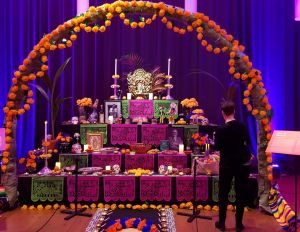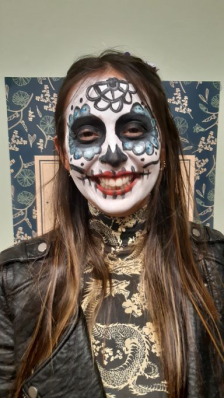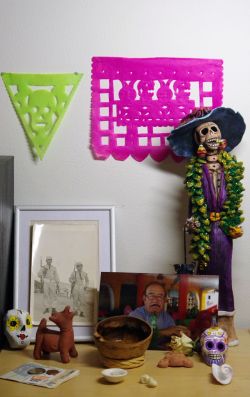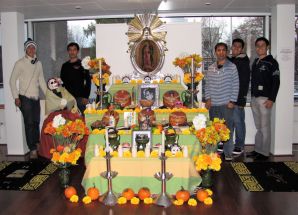Mexican Day of the Dead in Finland
| Mexican Day of the Dead in Finland | ||||
|---|---|---|---|---|
| In the national inventory | ||||
|
Practitioners and people who know the tradition well

Día de los Muertos, or the Day of the Dead, is a globally recognized indigenous peoples’ celebration in Mexico. In 2008, it was added to UNESCO list of Intangible Cultural Heritage as the Indigenous Festivity dedicated to the Dead.
The festival is traditionally celebrated annually in Mexico, but it is also part of the traditions of Mexicans living in other parts of the world. The Day of the Dead is a very meaningful celebration for Mexicans, but it has also established itself in circles where the tradition was introduced later.. On this day people have the opportunity to symbolically connect with their deceased loved ones.
Finland's Mexican community consists of a little over 1,500 individuals, representing both first and second generations. Not everyone actively practices in the tradition, but a significant portion of the community celebrates the holiday in a more subdued manner within their immediate circles. In many homes across Finland, hundreds of day of the dead altars are set up annually. Anyone who wishes to show respect to their deceased loved ones in a festive and joyful way can participate in the celebration.
The Day of the Dead is celebrated every year in different parts of Finland.. Day of the Dead altars have been constructed in cities such as Rovaniemi, Turku, Joensuu, Tampere, Jyväskylä, Oulu, Riihimäki, Hyvinkää, Sipoo, Espoo, Vantaa, and Helsinki. Additionally, many museums and public institutions have opened their facilities to receive them.. The Embassy of Mexico in Finland has often supported the constructions of these altars.
Perhaps, here in Finland when October is about to end and November is approaching, the distance, the longing, the sadness of moving abroad, the memory of one's own deceased and the long nights will bring out feelings and emotions of these communities and the people who build the altars.
Practising of the tradition
The way the deceased are celebrated varies in different parts of the world. Halloween, which originated in the United States, has spread worldwide, while in Finland, people have celebrated Kekri and All Saints Day. IIn the Mexican tradition of the Day of the Dead, the dead are viewed lovingly, and scaring, for example, is not part of the tradition.

On the Day of the Dead, people remember their deceased loved ones. This celebration is not limited to the construction of altars, although they are one of the most representative signs of this tradition.. Other customs on this day include cleaning graves and creating various decorations and foods. Singing, dancing, and prayer are also part of the celebrations. Preparations are done meticulously, because in some places it is believed that the deceased can influence the present: A deceased individual can bring prosperity (such as a bountiful corn harvest) or misfortune (sickness, accidents, financial difficulties, etc.) depending on whether they receive gifts or not.
In Mexico, the Day of the Dead usually takes place every year between October 31 and November 2,, but the specific start and end dates can vary depending on the regions and communities. Different days may hold specific meanings for altars. For example, October 27th is dedicated to former pets, October 28th to victims of accidents or violent deaths, October 29th to those who drowned, October 30th to forgotten or homeless individuals, October 31st to unborn babies, and November 1st is the actual Day of the Dead – Día de todos los Muertos.
Altars play a central role in practicing this tradition. The first step in building an altar is to select an appropriate space and decide for whom it will be dedicated. Altars can be adorned with colorful and white
tablecloths, fabrics, and tissue paper (papel picado). Altars should include water, salt, candles, as well as flowers or fruits. Some of these elements are related to the four elements of nature. Each element has its own meaning.. For instance, water represents the purity of the soul and the origin of life. Its purpose is to comfort and quench the thirst of the weary deceased on their journey. Candles, on the other hand, light the path of the deceased so they can reach the places where they are expected. Salt is a purifying element that ensures the deceased's body remains undamaged during their back-and-forth journey for the next year.
Additionally, altars can also include items that remind the living of their deceased loved ones. On altars, there are "bread of the dead", sugar skulls and photographs, whose purpose is to give symbolic presence to the deceased.. Incense or copal is used to cleanse bad energies and so that the person evoked can reach the altar safely.. Cempasúchil flowers are placed for their color and scent, which helps guide the deceased to the altar. Additionally, favorite foods and drinks of the deceased, as well as personal belongings or things they might miss, are offered, ranging from toys to favorite magazines to cigarettes.
In Mexico, altars can vary depending on the community and region. In areas with a higher population of indigenous communities, such as Guerrero, Morelos, Sonora, Michoacán, Nayarit, Estado de México, Querétaro, Puebla, Veracruz, Chiapas, Oaxaca, and Tabasco, preparations can begin earlier in the fall. The tradition includes communal tasks such as collecting cempasúchil flowers, creating paths with tea leaves, and making corn-based tamales.
Many altars are monumental works with different levels and meanings. Several places and communities are internationally recognized for their practice. For example, San Andrés Mixquic south of Mexico City, the island of Janitzio in Lake Pátzcuaro in Michoacán, Xilitla in San Luis Potosí, and Santa María del Tule in Oaxaca are known for their dedication to this tradition. In particular, Mexico City’s central square, El Zócalo, has been a central location for Día de los Muertos celebrations since 2016, with massive altars, parades featuring giant skulls and skeletons, with a significant boost in international visibility after being featured in the opening sequence of a James Bond film. The 2017 Disney movie “Coco”; also helped introduce the tradition of Día de los Muertos to children around the world. Both are examples of how non-religious popular culture has influenced this tradition.
The background and history of the tradition
Day of the Dead has a long history. Indigenous peoples in Mexico and Central America, such as the Maya and Aztecs, honored the deceased by celebrating already thousands of years ago. According to ancient beliefs, these celebrations were held in honor of the deceased, and from these festivities emerged the tradition of honoring the dead. The tradition of Day of the Dead gradually incorporated elements of catholicism, including the celebration of deceased saints, when spanish conquerors arrived in Mexico in the 16th century.

Day of the Dead is one of the many outcomes of the encounter between two worlds. Dr. Saúl Millán, an expert from the Mexican Institute of Anthropology and History, presents in several articles the pre-Latin American Mexican concept of death, which is connected to the general perception of the cosmos and the universe. "The cosmos was thought to be a unit divided into two opposing halves. One bright, hot, and the other cold, subterranean, and moist, with a tree in the middle that connected the celestial forces to the subterranean (...) This dual conception of the cosmos allowed them to think of the annual cycle in two opposite seasons: dry and rainy, which mark periods of transition.. The Day of the Dead festival essentially closes the cycle related to the growth of corn. In fact, the Day of the Dead festival is a harvest festival meant to share the first fruits of the season with the deceased".
The indigenous celebration was held in mid-September and played a crucial role in evangelization, as Catholicism was able to replace and merge some elements of indigenous traditions into Catholic religious images and creeds. In Finland, too, the memory of the deceased is observed around the same time of year.
All Saint' Day, the celebration of Kekri, and Halloween have all contributed to this tradition. With the current cultural exchange, it is easy to see that Finns, too, are curious to learn more about this colorful and fascinating Mexican tradition.
One of the most active institutions in promoting and spreading the Day of the Dead tradition in Finland is the Helinä Rautavaara Museum in Espoo. Since 1998, the museum has brought together artists and members of the Mexican community to collaborate with the Embassy of Mexico in building a traditional Day of the Dead altar. In 2000, Helsinki Art Museum HAM dedicated an altar to great artists: Tina Modotti, Diego Rivera, and Frida Kahlo. The skeleton figures made of papier-mâché (technique known in Mexico as Mexican cartonería) for the altar were commissioned from the famous Linares family, known for their expertise in crafting such figures. The Wäinö Aaltonen Museum curated the exhibition "Death and Its Many Faces"; in 2010, which featured various works of art related to the theme of death and included a Mexican altar. The National Museum of Finland, in collaboration with the Embassy of Mexico, built an altar in 2019 dedicated to the artist Francisco Toledo. In 2021, in Helsinki, Askelten Palo ry organized a cultural event in collaboration with Lapinlahden Lähde, featuring a Mexican Day of the Dead altar. In 2022, in Helsinki, the cultural center Ninho ry, in collaboration with the Embassy of Mexico, the Arts Promotion Centre TAIKE, and Annantalo Children's Cultural Center, brought a Day of the Dead altar from Mexico City. That same year, the art collective Jaranas del Norte organized a Day of the Dead Fandango, a festival centered around the tradition, in Helsinki.
The oldest online article advertising a Day of the Dead altar in Finland dates back to 1993 at Taideteollisuusmuseo (current Design Museum Helsinki) in Helsinki.
The transmission of the tradition
Many Mexicans have their first encounter with the Day of the Dead tradition in their childhood. The traditions of Day of the Dead and altars are woven into a celebration that is observed both within families and as well as in community spaces. The tradition is primarily passed down within families, but in Finland, for example, the Mexican community plays a central role in transmitting the tradition.
Altars built across different parts of Finland introduce new people to the tradition. Many of these altars, constructed in public spaces and on display, are made possible through the support of cultural, artistic, and educational institutions that are familiar with and promote this tradition. They are built in collaboration between Mexicans, Latin Americans, and Finns.
In Finland, there are several associations, cultural centers, museums, educational institutions, and organizations that are motivated each year, for various reasons, to pay their respects to the deceased in this colorful and lively manner. For example, the Ninho Cultural Center spreads the tradition among Finnish children, Askelten Palo ry through dance, Jaranas del Norte Collective through music and dance, the Helinä Rautavaara Museum with its traditional Day of the Dead altar, and the Finland-Mexico Association in various ways. In addition to these, cultural centers and libraries across Finland participate in the transmission of the Day of the Dead tradition. It is important to emphasize the role of the Embassy of Mexico in supporting institutions and communities interested in building their own altars.
The future of the tradition

The celebration of the Day of the Dead has become one of the most famous symbols of Mexican culture. This tradition is vibrant both within the country and beyond its borders. It is an ancient yet modern, living, and current tradition. It possesses communal continuity and is constantly renewed, not only in Mexico but also worldwide. Art and literature complement its universality. The Day of the Dead tradition encompasses symbolic elements from Mexican folklore, including poems, sculptures, paintings, crafts, skulls, dances, music, songs, films, and various representations of what the world of the dead is like.
Examples of these folk elements include "Las Calaveras literarias" a tradition of black humor where literary characters humorously recount how death claimed the deceased. These involve sculptures and everyday scenes featuring skulls and skeletons. Death itself is depicted as an elegant and colorful woman, much like the famous Catrina—José Guadalupe Posada's engraving in which he portrayed death's face as that of a stylish woman, later painted by Diego Rivera in his mural "Sueño de una tarde dominical en la Alameda Central".
This combination of tradition, art, culture, and spiritual sentiment ensures the continuity of the tradition. Writer Octavio Paz explored the Day of the Dead celebration in his essay "Laberinto de la Soledad". According to Paz, public carnivals for Mexicans are a way to channel the chaos and special moments of life—a time when people can open up, let go, and be nonexistent. The celebration allows for everything that everyday culture inhibits. Paz describes the celebration as follows: "The cult of life, if it is truly profound and total, is also the cult of death, because the two are inseparable. A civilization that denies death ends by denying life.(...) To the people of New York, Paris, or London, "death" is a word that is never pronounced because it burns the lips. The Mexican, however, frequents it, jokes about it, caresses it, sleeps with it, celebrates it; it is one of his favorite toys and most steadfast love.".
In this sense, the ancestral tradition of the cult of the dead, as understood in Mexican culture, is guaranteed a future, both here and elsewhere. Death is always something accompanied by uncertainty. It nourishes the imagination and creates hope for those who believe that there is life after death.
The community/communities behind this submission
Article is part of the Ambassadors of Living Heritage -project and it was written by Rosamaria Bolom vuonna 2023 ja sen on kirjoittanut Rosamaría Bolom.
Bibliography and links to external sources of information
Online sources in Finnish
Kuolleiden päivä Unescon ihmiskunnan aineettoman kulttuuriperinnön luettelossa
Hakkarainen, Antti. Kuoleman Kautta Elämään. Kuolleiden Päivän Meksikon Kulttuurissa. Lahden Ammattikorkeakoulu. Opinnäytetyö.
Maunula, Leena. Vainajien päivän alttari katetaan myös Helsingissä. Helsingin Sanomat. 3.11.1993
YLE oppiminen Pyhänpäivä, Kekri ja Halloween - juhlia kuolleiden muistamiseksi.
Päivyri.fi. Pyhäinpäivän historia ja perinteet. Suomalaisesta kalenterista, sen historiasta ja etymologiasta.
Serena, Edgar. Kuolleiden Päivä. Día de los Muertos. Maailman antropologian blogijulkaisu.
Online sources in other languages
UNESCO. Día de los Muertos: El regreso de lo querido.
Aguilar Guzmán, Fernando. Día de Muertos, una fiesta para evangelizar. Gaceta Especial UNAM.
Aguilar Rubín, Marcela. Fiesta de Muertos en México, Patrimonio de la Humanidad.
CONACULTA. La Festividad Indigena dedicada a los Muertos en México. Patrimonio Cultural y Turismo. Cuadernos 16.
Islas, Brenda. Día de Muertos, una tradición muy viva. Naciones Unidas. Noticias ONU.
Paz, Octavio. Día de Muertos. Fondo de Cultura Económica. El Laberinto de la Soledad. Todos Santos.
